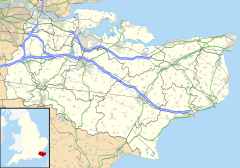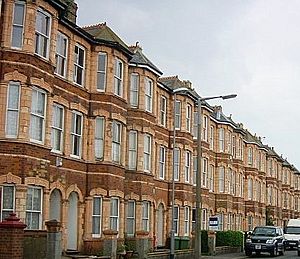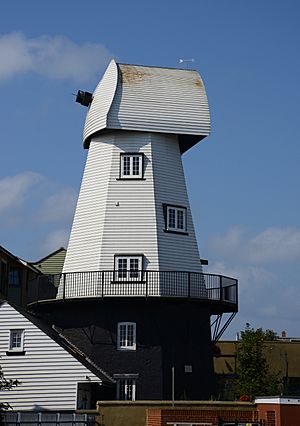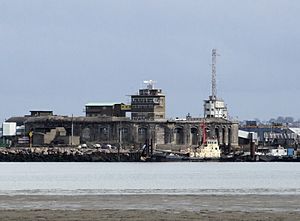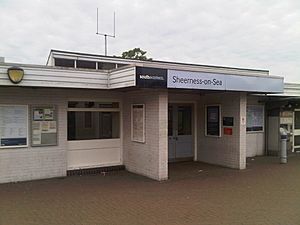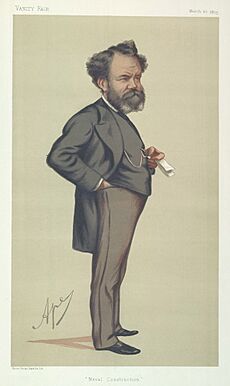Sheerness facts for kids
Quick facts for kids Sheerness |
|
|---|---|
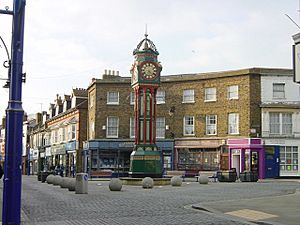 Sheerness clock tower |
|
| Population | 13,249 (2021 census) |
| OS grid reference | TQ919749 |
| • London | 37 miles (60 km) W |
| District | |
| Shire county | |
| Region | |
| Country | England |
| Sovereign state | United Kingdom |
| Post town | SHEERNESS |
| Postcode district | ME12 |
| Dialling code | 01795 |
| Police | Kent |
| Fire | Kent |
| Ambulance | South East Coast |
| EU Parliament | South East England |
| UK Parliament |
|
Sheerness (pronounced sheer-NESS) is a port town and civil parish located at the mouth of the River Medway. It sits on the north-west side of the Isle of Sheppey in north Kent, England. With about 13,249 people, it's the second largest town on the island. The nearby town of Minster is a bit bigger with 16,738 residents.
Sheerness started as a fort in the 1500s. This fort was built to protect the River Medway from enemy ships. In 1665, plans began for Sheerness Dockyard. This was a place where warships could get supplies and be fixed. Samuel Pepys, who worked for the navy, liked this spot for shipbuilding more than Chatham. After a Dutch attack on the Medway in 1667, the old fort was made stronger. In 1669, a Royal Navy dockyard was officially set up in the town. Warships were kept and repaired here until the dockyard closed in 1960.
Later, in the 1800s, Sheerness became a popular seaside resort. A pier and a promenade were built, attracting visitors. Today, industry is still very important to the town. The Port of Sheerness is one of the UK's main places for importing cars and fresh food. Sheerness is also special because it had one of the UK's first co-operative societies. It was also home to the world's first multi-storey building with a strong metal frame.
Contents
History of Sheerness
The very first building in Sheerness was a fort. King Henry VIII ordered it built to stop enemy ships from entering the River Medway. This was important to protect the naval dockyard at Chatham. In 1666, work started on a stronger fort. But before it was finished, the Dutch navy attacked in 1667. They captured the town and destroyed the fort. This event is known as the raid on the Medway.
After the Dutch attack, Samuel Pepys ordered the building of Sheerness Dockyard. This was an expansion of the Chatham dockyard. There wasn't a proper town in Sheerness yet. So, many workers first lived on old ships called hulks. By 1738, workers had built the first houses in Sheerness. They used materials they were allowed to take from the dockyard. They painted their homes with the grey-blue naval paint. This led to the houses being called the Blue Houses. Over time, this became Blue Town, which is now a part of Sheerness next to the dockyard. The modern town of Sheerness started later in the 1700s. It was called Mile Town because it was about a mile from the dockyard.
In 1797, some unhappy sailors in the Royal Navy had a protest near Sheerness. This was part of the Spithead and Nore mutinies.
By 1801, the population of the area, including Sheerness and Minster, reached 5,561 people. In 1816, one of the UK's first co-operative societies started in Sheerness. It was called the Sheerness Economical Society. It began as a bakery but grew to sell many different goods. It mainly served the dockyard workers and their families.
In the early 1820s, a fire destroyed the old Blue Houses. New houses were built, and the dockyard was greatly improved. A tall brick wall and a moat were built around the dockyard for protection. These stayed until the late 1800s. As the town grew east, away from the dockyard, the whole area became known as Sheerness. Its name came from the clear water at the mouth of the River Medway. The rebuilt Dockyard had many new and impressive buildings. For example, the Sheerness Boat Store, finished in 1860, was the world's first multi-storey building with a strong metal frame. It still stands today.
From the time the dockyard was finished until 1960, Sheerness was a base for the Nore Command of the Royal Navy. This command was in charge of protecting British waters in the North Sea.
In 1863, mains water was brought to the town. The Isle of Sheppey's first railway station opened at the dockyard. By the end of the 1800s, Sheerness became an official town. It formed its own civil parish, separate from Minster-in-Sheppey. The 1901 Census showed Sheerness had 18,179 residents and 2,999 houses.
Sheerness became popular as a seaside resort because it had low rainfall and lots of sunshine. Tourists arrived by steamboat and train. The Sheppey Light Railway opened in 1901. It connected the new Sheerness East station with the rest of the island. However, it closed in 1950 due to a lack of demand. The Sheerness and District Tramways, which opened in 1903, only ran until 1917.
During the Second World War, a protective barrier called the Shoeburyness Boom ran across the Thames Estuary. It went from Sheerness to Shoeburyness in Essex. This boom helped protect ships from submarine attacks. A similar structure was built in the early 1950s to protect against Soviet submarines. The Sheerness end of this boom was taken down in the 1960s.
In March 1960, the Royal Navy stopped using the Sheerness dockyard. The Medway Port Authority took over the site for business use. The dockyard closing meant thousands of people lost their jobs. Most of the nearby houses and shops in the Bluetown area were later left empty and torn down. By the 1961 census, Sheerness's population had dropped to 13,691. The dockyard closure also caused the Sheerness and District Cooperative Society to decline. Many of its members were dockyard workers.
In 2003, the Beachfields Park project was started. Its goal was to share the history of Beachfields and protect it for the future. Students from local schools helped research the funfair, bandstands, and other features of the park. As part of this project, students wrote a book called Tales of Beachfields Park.
As of 2007, Bluetown is an industrial area. Sheerness has become the UK's largest port for importing cars. Before the Dockyard closed, 25 of its old buildings were listed as important for their "architectural distinction and value." But most of them were later torn down. In the early 2000s, a big effort was made to save the remaining buildings. Several have been fixed up and are now used as homes.
Mills in Sheerness
Sheerness has had four windmills over time.
- The Little Mill was a smock mill that existed before 1813 and burned down in 1862.
- The Hundred Acre Mill was a small tower mill. It was last used in 1872 and torn down in 1878. Only its base remains today.
- The Great Mill was also a smock mill. Its building started in 1813 and finished in 1816. It was torn down in 1924, leaving its base. A replica mill body was built on this base and now serves as flats. In 2008, a fire started in the mill tower, but it was not caused by arson.
- Little is known about the fourth windmill. It was said to be a vertical axle windmill designed by Stephen Hooper.
How Sheerness is Governed
Sheerness is part of the parliamentary constituency called Sittingbourne and Sheppey. This means people in Sheerness vote for one person to represent them in the UK Parliament. Since 2010, Gordon Henderson of the Conservative Party has been the Member of Parliament (MP) for this area.
Sheerness is also part of the local government district of Swale. The town has three seats on the Swale Borough Council. This council runs local services like parks, rubbish collection, and council housing. Kent County Council handles bigger services like education and social services. Both councils work together on town planning and road maintenance.
For much of the last century, the Labour Party has had the most support in Sheerness. This is mainly because of the town's industrial past.
Geography of Sheerness
Sheerness is located in the north-west corner of the Isle of Sheppey in North Kent. To the north, there are sandy beaches along the coast of the Thames Estuary. To the west, the River Medway flows into the Estuary. There's an area of wetlands called The Lappel between the river and the south-western part of town. Marshland lies to the south and east. The main type of rock on the Isle of Sheppey is London Clay.
The closest towns to Sheerness are Minster, about 1 mile (1.6 km) to the east, and Queenborough, 2 miles (3.2 km) to the south. The villages of Minster-on-Sea and Halfway Houses are 1 mile (1.6 km) to the south-east. The village of Grain is about 2 miles (3.2 km) to the west, across the River Medway.
The main shopping and fun areas of Sheerness are along the north coast, where it's easy to get to the beach. The industrial areas are in the west, next to the wetlands and the River Medway. The Bluetown industrial area and the Port of Sheerness are in the north-western part of the town. The homes are mostly in Mile Town (central) and Marine Town (eastern areas).
The average temperature in Sheerness is about 10°C (50°F). The warmest months are July and August, with temperatures around 21°C (70°F). The coolest months are January and February, with temperatures around 2°C (36°F). Sheerness gets about 28 inches (710 mm) of rain each year. It also gets about 1,700 hours of sunshine per year, with the most sunshine from May to August. There are usually fewer than six days of snow and about 16 days with thunder each year.
People of Sheerness
| Sheerness | Swale | England | |
|---|---|---|---|
| Total population | 11,654 | 122,801 | 49,138,831 |
| Foreign born | 3.1% | 3.6% | 9.2% |
| White | 98% | 98% | 91% |
| Asian | 1.1% | 0.7% | 4.6% |
| Black | 0.2% | 0.3% | 2.3% |
| Christian | 72% | 76% | 72% |
| Muslim | 0.6% | 0.4% | 3.1% |
| No religion | 19% | 15% | 15% |
| Over 65 years old | 13% | 16% | 16% |
| Source: 2001 UK census | |||
In the 2001 UK census, Sheerness had 11,654 people. The average age of people in Sheerness was 34.7 years, which is younger than the average for the whole Swale area (38.2 years).
Compared to the rest of England, Sheerness has a small number of people born outside the UK, about 3%. Most residents (98%) were recorded as white. The largest minority group was Asian, at 1.1% of the population. In the 2000s, more people born outside the UK moved to Sheerness, including many from Eastern Europe.
Economy and Jobs
The Port of Sheerness is a very important part of the Isle of Sheppey's economy. It covers more than 1.5 million square metres. It is one of the UK's biggest ports for importing foreign cars. It also handles thousands of tonnes of fruits and meat from all over the world. Because land is cheap and there's good transport (like a railway line), many businesses have set up near the port. These include companies that make medicines, steel, sausages, and even garden gnomes!
Major employers in Sheerness include HBC Engineering Solutions, Sheerness Steel, Regis Furniture, and The Bond Group. The steel mill started in 1972. It was designed to recycle scrap steel into rods and coils. It has faced threats of closure and changes in ownership. The port also has a centre for sailors, which was updated in 2015.
The seafront is popular with tourists. In 2007, Sheerness's town centre, which had been recently improved, had over 200 shops.
In 2001, about 35.8% of people aged 16–74 in Sheerness worked full-time. About 6.2% were unemployed, which was higher than the national average of 3.4%. Also, 44% of people in Sheerness aged 16–74 did not have any academic qualifications. This was higher than the 34% in the whole Swale area.
Culture and Fun
Sheerness has a sand and shingle beach. It has been given a European Blue Flag award for being clean and safe. There are flower gardens along the seafront, and a sea wall forms a nice walking path. The Sheppey Leisure Complex near the beach has a swimming pool and courts for badminton, squash, and tennis.
Other sports clubs include Sheerness Town Bowls Club, Sheerness East Cricket Club, and the Isle of Sheppey Sailing Club. The main football club on the island is Sheppey United. They were formed in 1890 and have played in various leagues. In 2022/23, the club will play in the Isthmian League after being promoted. You can also play sports for free at the town's recreation grounds like Beachfields Park.
The annual Sheerness Promenade Festival celebrates arts and heritage. It started in 2011 and takes place in late July at places like the Sheppey Little Theatre.
Sheerness has a library and clubs for photography, music, singing, dancing, and writing. The youth club in Meyrick Road has been helping young people for over 50 years.
The town centre of Sheerness has the tallest freestanding cast iron clock tower in Kent. It is 36 feet (11 metres) tall. It was built in 1902 to celebrate the crowning of King Edward VII. In 2002, the clock tower was fixed up to celebrate the Silver and Golden Jubilees of Queen Elizabeth II.
Local Media
The Sheerness Times Guardian is the only newspaper that serves the town and the island now. It is owned by the KM Group. The Sheppey Gazette closed in 2011 after about 100 years.
Local news and TV shows come from BBC South East and ITV Meridian. TV signals are received from the Bluebell Hill TV transmitter.
Local radio stations include BBC Radio Kent (96.7 FM), Heart South (102.8 FM), Gold (603 AM), and the local community radio station, BRFM 95.6 FM. BRFM broadcasts 24 hours a day from Minster-on-Sea and is run by volunteers. It plays a variety of music, news, and local event information. In 2011, BRFM got a five-year extension to its broadcast licence.
Sheerness and the Isle of Sheppey also have another community radio station called Sheppey FM. It broadcasts on 92.2 FM from Sheerness across the island.
Getting Around Sheerness
The town has a train station called Sheerness-on-Sea railway station. It's on the Sheerness Line, which connects the town to Sittingbourne, about 6 miles (9.7 km) south on the mainland. Trains run hourly to Sittingbourne (more often during busy times). From Sittingbourne, you can connect to trains going to London Victoria, London St Pancras International, Ramsgate, and Dover Priory.
Bus services in Sheerness are run by Chalkwell Coaches. They have routes that connect Sheerness to Queenborough, Rushenden, Minster, Eastchurch, Warden, Leysdown-on-Sea, Iwade, and Sittingbourne.
No passenger ferry services currently leave from Sheerness. However, a company called Olau Line used to run a ferry service to Vlissingen in the Netherlands from 1974 to 1994.
The A249 road ends at Sheerness. This road goes from Maidstone through Sittingbourne. It crosses the M2 motorway near Sittingbourne and the M20 motorway near Maidstone.
Education in Sheerness
Until September 2009, the Isle of Sheppey was the only area in Kent that still used a middle school system. On the island, primary schools taught students from ages 4 to 9. Middle schools taught ages 9–13, and secondary schools taught ages 13–18. Minster College in the nearby town of Minster was the only secondary school on the island. Sheerness had one middle school, Isle of Sheppey Academy.
On 1 September 2009, Cheyne Middle School and Minster College joined together to become The Isle of Sheppey Academy (now called Oasis Academy Isle of Sheppey). This change brought the island in line with the rest of the UK, which uses a two-tier system (primary school, then secondary school). The Isle of Sheppey Academy now teaches students from Year 6 to Year 11, and also has the island's sixth form for older students. Sheppey College, in Sheerness, is part of Canterbury College and offers many further education courses.
Famous People from Sheerness
- Thomas King (before 1660 – 1725), a soldier and Member of Parliament (MP).
- Sir Edward James Reed, KCB, FRS (1830–1906), a naval architect, writer, and politician. He was born in Sheerness and trained there.
- James McCudden (1895–1918), a famous pilot in World War I, who won the Victoria Cross. He lived in Sheerness from 1909.
- Sir Stanley Hooker (1907–1984), a mathematician and jet engine engineer. He invented the VTOL engine and was born in Sheerness.
- William Penney, Baron Penney (1909–1991), a mathematician and physicist. He was a key person in Britain's nuclear weapons development. Penney grew up in Sheerness.
- Richard Beeching (1913–1985), known as Dr. Beeching, was an engineer who famously cut down many railway lines in Britain.
- Uwe Johnson (1934–1984), a German writer and scholar, lived in Sheerness.
- Rod Hull (1935–1999), an English comedian famous for his puppet, Emu.
- Richard Carpenter (born 1972), a footballer.
- Luke James Uggles Eatwell (born 1987), a professional wrestler known as Zack Sabre Jr.
Images for kids
See also
 In Spanish: Sheerness para niños
In Spanish: Sheerness para niños


